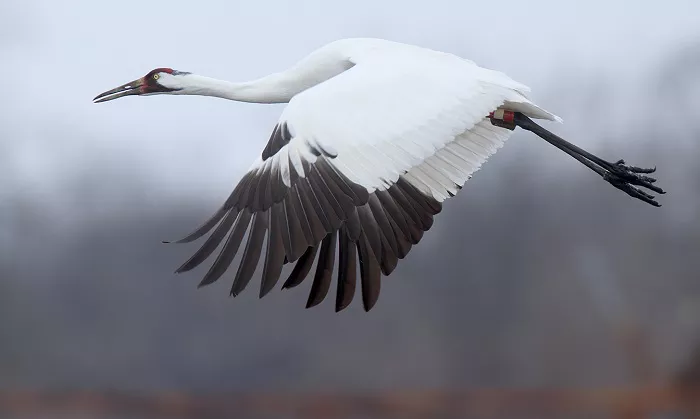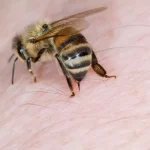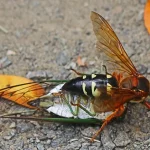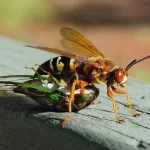The whooping crane is one of the most majestic and rare birds in North America, known for its striking white feathers, black wingtips, and distinctive whooping call. This crane species has become a symbol of resilience and hope, embodying deep spiritual meanings and cultural significance. In this article, we will explore the whooping crane’s symbolism, its spiritual meaning, and how it is perceived in various cultures. Additionally, we will examine the symbolism of whooping cranes with different colors, their role in dreams, and the myths and legends surrounding these birds.
Whooping Crane Spiritual Meaning
The whooping crane holds a strong spiritual meaning, often symbolizing transformation, freedom, and perseverance. With a near-extinct population, the whooping crane’s recovery is seen as a miraculous comeback, and as such, it represents resilience and hope in overcoming adversity.
Symbol of Hope and Resilience
In the modern world, the whooping crane’s symbolic meaning is tied to the perseverance and resilience it has shown in recovering from the brink of extinction. At one point, the whooping crane population had dwindled to just 15 birds, but conservation efforts have helped bring the species back from near extinction. This remarkable recovery story has made the whooping crane a symbol of hope for many people, showing that even the most dire situations can improve with effort, care, and dedication. Spiritually, the whooping crane inspires individuals to remain resilient, even in the face of great challenges, and to always push forward despite obstacles.
Symbol of Transformation and New Beginnings
The whooping crane also embodies transformation and the potential for new beginnings. These birds are known for their seasonal migrations, traveling vast distances from their breeding grounds in Canada to their wintering locations in the southern United States. This migratory behavior symbolizes movement, change, and the cyclical nature of life. Spiritually, the whooping crane can signify a new chapter or phase in life, urging individuals to embrace transformation and move forward with confidence.
Symbol of Freedom and Independence
The whooping crane’s ability to soar high above the earth with grace and freedom is often seen as a symbol of independence. These birds are known for their long migrations, and their ability to navigate across vast distances reflects their deep connection to freedom. The spiritual significance of the whooping crane encourages individuals to break free from constraints, explore new horizons, and embrace their independence. It serves as a reminder that true freedom lies in self-determination and the courage to pursue one’s own path.
Symbol of Family and Togetherness
The whooping crane is also a symbol of family and unity. These birds are known to form strong family bonds, particularly between parents and their young. The parents take on a protective role, guiding their offspring during migration and teaching them how to thrive in the wild. The whooping crane’s deep commitment to family life represents the importance of nurturing relationships and staying connected to loved ones. In a spiritual sense, the bird can signify the need to strengthen familial bonds, protect those close to you, and foster a sense of unity within your community.
See Also: 33 Whooping Crane Quotes, Sayings, and Proverbs
Whooping Crane Symbolism (In Different Countries)
Cultural perceptions of whooping cranes vary across the globe, with each country attributing different meanings to these majestic creatures. While the bird is native to North America, its symbolic presence can be found in many cultures due to its rare beauty and remarkable recovery story.
Whooping Cranes in North American Culture
In North America, the whooping crane is often viewed as a symbol of conservation, environmental awareness, and hope. Its near extinction in the 1940s and subsequent recovery efforts have made it an icon of environmental restoration. In Native American cultures, the crane, in general, is revered as a spiritual messenger and a symbol of wisdom. The whooping crane, due to its rarity and distinctiveness, carries this symbolism to a greater extent, representing a divine connection between the natural world and human beings.
For the Indigenous peoples of North America, the crane is also a symbol of harmony and balance in the natural world. The whooping crane, as a rare species, represents the delicate balance between nature and human intervention. Its recovery is a sign that, with concerted effort and respect for the natural world, humans can restore and protect endangered species.
Whooping Cranes in Chinese Culture
In Chinese culture, cranes are highly symbolic birds that represent longevity, prosperity, and good fortune. The whooping crane, with its striking appearance and graceful movements, is no exception. Cranes in Chinese mythology are often seen as celestial creatures that can grant wishes or bring blessings to those who honor them. While the whooping crane is not as prominent as other crane species in Chinese culture, it is still viewed as a symbol of longevity and the enduring spirit of life.
The Chinese also associate cranes with the idea of immortality. The whooping crane, with its regal presence and rare status, can be seen as a symbol of the pursuit of eternal life and wisdom. In this sense, the bird serves as a reminder to cherish every moment and pursue spiritual enlightenment.
Whooping Cranes in Japanese Culture
In Japan, cranes, particularly the red-crowned crane, are revered as sacred animals that embody longevity, peace, and good fortune. The whooping crane, while not native to Japan, shares many of these symbolic meanings. Japanese folklore often speaks of cranes as beings that possess great wisdom and strength. The idea of folding 1,000 paper cranes to make a wish is a well-known Japanese tradition, and the whooping crane can be seen as a manifestation of this hope and desire for spiritual fulfillment.
In the context of the whooping crane, Japanese culture would view the bird as a representation of resilience and determination, akin to the strength needed to overcome obstacles and continue on one’s path despite adversity. Its migration patterns also symbolize the importance of balance between the natural world and human endeavors.
Whooping Cranes in European Culture
In European culture, cranes are often associated with the arrival of spring, the renewal of life, and the connection between life and death. While the whooping crane is not as well-known in Europe as other crane species, its symbolism is similar to that of other cranes. The whooping crane is seen as a bird of transition, representing change, growth, and the cycle of life.
Cranes, in general, are also symbols of protection, guardianship, and spiritual guidance. In European folklore, cranes are often seen as protectors of the home and family, guiding souls on their journey from life to the afterlife. The whooping crane, with its protective and nurturing behavior, embodies these same qualities, making it a symbol of spiritual guardianship.
Whooping Crane Symbolism (With Different Colors)
The whooping crane’s symbolic meaning can be further explored by examining the bird’s physical appearance, particularly the colors that characterize it. Each color in the whooping crane’s plumage can carry its own symbolic significance.
White Whooping Cranes
The white feathers of the whooping crane are perhaps the most noticeable and have deep symbolic meaning across many cultures. White is universally associated with purity, innocence, and spiritual clarity. For the whooping crane, the white color is a symbol of spiritual enlightenment and a connection to the divine. The white plumage can signify new beginnings, transformation, and the shedding of old energies. It is a color that represents a fresh start or a clean slate, encouraging individuals to let go of past burdens and embrace a brighter future.
Black Wingtips of the Whooping Crane
The black wingtips of the whooping crane provide a stark contrast to the bird’s otherwise white feathers. In many spiritual traditions, black is a color associated with mystery, protection, and transformation. The black wingtips may represent the bird’s deep connection to the earth and its ability to navigate the challenges of life. These dark feathers can be seen as a protective element, guiding the bird through its migratory journey and offering a sense of safety and security in the face of adversity.
Yellow and Gold in Whooping Cranes
While not as prominent as the black and white feathers, the yellow and gold tones found in the whooping crane’s plumage, particularly around the head and neck, carry significant symbolism. Gold is associated with wealth, prosperity, and the divine, while yellow represents intellect and clarity. These golden hues can be seen as symbols of spiritual wealth, inner knowledge, and the pursuit of enlightenment. The whooping crane’s subtle golden accents serve as a reminder to seek wisdom and to embrace the richness of life’s journey.
Whooping Crane Symbolize in Dreams
Dreams about whooping cranes can be rich with meaning, often related to transformation, perseverance, and the need for guidance. The presence of a whooping crane in a dream can have several interpretations, depending on the context and the emotions felt during the dream.
Whooping Crane Dreams and Transformation
If you dream of a whooping crane, it may symbolize a period of transformation in your life. The crane’s migratory nature and its ability to adapt to changing environments can reflect your own need to embrace change and move forward in life. The dream could suggest that you are on the brink of a new chapter and should prepare yourself for the opportunities and challenges that come with it.
Whooping Crane Dreams and Resilience
Dreaming of a whooping crane can also be a symbol of resilience, particularly if you are currently facing a difficult situation. The crane’s recovery from near extinction serves as a reminder that, no matter how challenging life may seem, perseverance and determination will lead to success. A dream about a whooping crane could be encouraging you to remain strong and keep pushing forward.
Whooping Crane Dreams and Freedom
A whooping crane appearing in your dream could signify a desire for freedom or a need to break free from limitations. The crane’s flight represents liberation and the ability to explore new horizons. If you are feeling restricted or confined in your waking life, the dream may be telling you to seek out opportunities for independence and growth.
Myths and Legends About Whooping Cranes
While the whooping crane itself does not have as many widespread myths and legends as some other birds, it has nevertheless become a part of local lore and has deep symbolic meaning in various cultures. The bird’s return from the brink of extinction has made it a symbol of hope and divine intervention. Many cultures view the whooping crane as a messenger, guiding individuals toward spiritual enlightenment and offering protection during times of change.
In some Native American traditions, cranes, in general, are seen as spiritual guides that help souls pass into the afterlife. The whooping crane, with its large and majestic presence, is considered a more powerful version of this spiritual messenger, embodying both grace and strength.
Conclusion
The whooping crane is a symbol of hope, resilience, transformation, and freedom. Its rarity and remarkable recovery have made it a powerful symbol in many cultures, embodying the ability to overcome challenges and embrace new beginnings. Whether viewed through its symbolic connection to family, its role in dreams, or its significance in myths and legends, the whooping crane continues to inspire awe and reverence.
Related topics:













